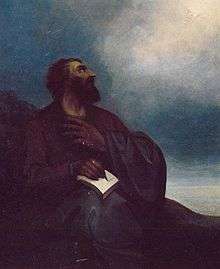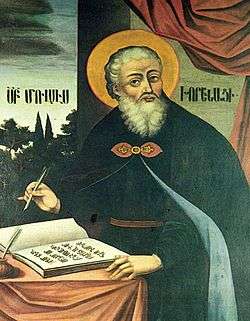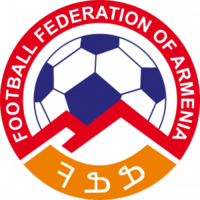Culture of Armenia
| Part of a series on the |
| Culture of Armenia |
|---|
 |
| History |
| People |
| Languages |
|
Traditions |
|
Mythology and folklore |
| Cuisine |
| Religion |
|
Music and performing arts |
| Sport |
|
Monuments
|
|
| Part of a series on |
| Armenians |
|---|
| Armenian culture |
|
Architecture · Art Cuisine · Dance · Dress Literature · Music · History |
| By country or region |
|
Armenia · Nagorno-Karabakh Republic Armenian diaspora |
| Subgroups |
| Hamshenis · Cherkesogai · Armeno-Tats · Lom people · Hayhurum |
| Religion |
|
Armenian Apostolic · Armenian Catholic Evangelical · Brotherhood · |
| Languages and dialects |
| Armenian: Eastern · Western |
| Persecution |
|
Genocide · Hamidian massacres Adana massacre · Anti-Armenianism |
|
Armenia Portal |

The culture of Armenia encompasses many elements that are based on the geography, literature, architecture, dance, and music of the people.
Creative arts
Literature
Literature began in Armenia around 401 A.D. The majority of the literary arts were created by Moses of Khorene, in the 5th century. Through the years the elements of literature have changed as the stories and myths were passed on through generations. In the late 17th century, Alexander Tertzakian was a renowned Armenian writer who created several works considered to be among Armenia's classics. During the 19th century, writer Mikael Nalbandian worked to create a new Armenian literary identity. Nalbandian's poem "Song of the Italian Girl" may have been the inspiration for the Armenian national anthem, Mer Hayrenik.

Mesrop Mashtots is considered to be the creator of the Armenian alphabet. This event which took place in the 5th century is considered to be one of the most important turning points of Аrmenian Literature
Movses Khorenatsi was a prominent Armenian historian from the period of late antiquity and the author of the History of the Armenians.
Khorenatsi is credited with the earliest known historiographical work on the history of Armenia written in Armenian, but was also a poet, or hymn writer, and a grammarian. The History of Armenia was written at the behest of Prince Sahak Bagratuni and has had an enormous impact on Armenian historiography. It was used and quoted extensively by later medieval Armenian authors. Although other Armenians, such as Agathangelos, had previously written histories on Armenia, Movses' work holds particular significance because it contains unique material on the old oral traditions in Armenia before its conversion to Christianity and, more importantly, traces Armenian history from Movses' day back to its origins.
Dance

The Armenian dance heritage has been one of the oldest, richest and most varied in the Near East. From the fifth to the third millennia B.C., in the higher regions of Armenia there are rock paintings of scenes of country dancing. These dances were probably accompanied by certain kinds of songs or musical instruments. In the 5th century Moses of Khorene (Movsés Khorenats'i) himself had heard of how the old descendants of Aram (that is Armenians) make mention of these things (epic tales) in the ballads for the lyre and their songs and dances.
One of the most energetic Armenian dances is the martial dance Yarkhushta. Yarkhushta is believed to have its origins in the early Middle Ages as it is mentioned in the works of Movses Khorenatsi, Faustus of Byzantium, and Grigor Magistros.[1] Yarkhushta has traditionally been danced by Armenian soldiers before combat engagements, partly for ritualistic purposes, and partly in order to cast off fear and boost battle spirit.[2]
The dance is performed by men, who face each other in pairs. The key element of the dance is a forward movement when participants rapidly approach one another and vigorously clap onto the palms of hands of dancers in the opposite row.[1]
Architecture

Classical Armenian architecture is divided into four separate periods. The first Armenian churches were built between the 4th and 7th Century, beginning when Armenia converted to Christianity, and ending with the Arab invasion of Armenia. The early churches were mostly simple basilicas, but some with side apses. By the 5th century the typical cupola cone in the center had become widely used. By the 7th century, centrally-planned churches had been built and a more complicated niched buttress and radiating Hrip'simé style had formed. By the time of the Arab invasion, most of what we now know as classical Armenian architecture had formed.

Carpets

Though women historically dominated carpet-weaving in Armenian communities, several prominent carpet-weavers in Karabakh are known to have been men, and in some cases whole families took up the art. The oldest extant Armenian carpet from the region, referred to as Artsakh during the medieval era, is from the village of Banants (near Gandzak) and dates to the early 13th century.[3] The first time that the Armenian word for carpet, gorg, was used in historical sources was in a 1242-1243 Armenian inscription on the wall of the Kaptavan Church in Artsakh.[4]
Art historian Hravard Hakobyan notes that "Artsakh carpets occupy a special place in the history of Armenian carpet-making. Common themes and patterns found on Armenian carpets were the depiction of dragons and eagles. They were diverse in style, rich in color and ornamental motifs, and were even separated in categories depending on what sort of animals were depicted on them, such as artsvagorgs (eagle-carpets), vishapagorgs (dragon-carpets) and otsagorgs (serpent-carpets). The rug mentioned in the Kaptavan inscriptions is composed of three arches, "covered with vegatative ornaments", and bears an artistic resemblance to the illuminated manuscripts produced in Artsakh.[4]
The art of carpet weaving was in addition intimately connected to the making of curtains as evidenced in a passage by Kirakos Gandzaketsi, a 13th-century Armenian historian from Artsakh, who praised Arzu-Khatun, the wife of regional prince Vakhtang Khachenatsi, and her daughters for their expertise and skill in weaving.[5]
Armenian carpet was also renowned by foreigners who traveled to Artsakh; the Arab geographer and historian Al-Masudi noted that, among other works of art, he had never seen such carpets elsewhere in his life.[6]
Art
The National Art Gallery in Yerevan has more than 16,000 works that date back to the Middle Ages, which indicate Armenia's rich tales and stories of the times. It houses paintings by many European masters as well. The Modern Art Museum, the Children’s Picture Gallery, and the Martiros Saryan Museum are only a few of the other noteworthy collections of fine art on display in Yerevan. Moreover, many private galleries are in operation, with many more opening every year, featuring rotating exhibitions and sales.

Lacemaking
Like Lacis, Armenian needlelace seems to be an obvious descendant of netmaking. Where lacis adds decorative stitches to a net ground, Armenian needlelace involves making the net itself decorative. There is some archaeological evidence suggesting the use of lace in prehistoric Armenia and the prevalence of pre-Christian symbology in traditional designs would certainly suggest a pre-Christian root for this art form. In contrast to Europe where lace was the preserve of the nobility, in Armenia it decorated everything from traditional headscarves to lingerie. Thus lacemaking was part of many women's lives.
Theater
Born in Western Canada, Atom Egoyan is now an internationally-known filmmaker who is celebrated for his contemporary work, including personal feature films and other related projects. He is the winner of many awards at international film festivals, such as the Grand Prix and international Critics’ Awards from the Cannes Film Festival and two Academy Award nominations for “The Sweet Hereafter”. Egoyan has also worked in the television and theatre industries, producing Wagner’s Die Walkure which was performed by the Canadian Opera Company in April 2004.[7] Egoyan's creation Ararat (2002) is about the 1915 Armenian Genocide perpetrated by Turks in the Turkish Ottoman Empire. It depicts the consequences and suffering of a child survivor Arshile Gorky, and is an incredibly made-movie for both Armenians and non-Armenians.[8]
Music

One of the most important parts of Armenian culture is the music, which has brought new forms of music in recent years, while maintaining traditional styles too. This is evidenced by the world-class Armenian Philharmonic Orchestra that performs at the beautifully refurbished Aram Khachaturian Concert Hall in the Yerevan Opera House, where one can also attend a full season of opera. In addition, several chamber ensembles are highly regarded for their musicianship, including the Komitas Quartet, Hover Chamber Choir, National Chamber Orchestra of Armenia and the Serenade Orchestra. Classical music can also be heard at one of several smaller venues, including the Yerevan State Musical Conservatory and the Komitas Chamber Music Hall. Jazz is popular in Armenia, especially in the summer when live performances are a regular occurrence at one of the city’s many outdoor cafés and parks. Armenian rock has made its input to the rock culture. The most known Armenian traditional instrument is the duduk (pronounced [duˈduk] or doo-dook).
Modern day Armenian artists have incorporated folk music into more modern jazz and rock genres so that the traditional music still influences their creations.
Inga and Anush Arshakyans are an unexpected duo who create ethno, contemporary tracks that are also full of Armenian spirit. After graduating from the Yerevan State Conservatory, the singers started performing together on the professional stage in 2000. Later, in 2009 Inga & Anush represented Armenia in the Eurovision Song Contest in Moscow. They ended up taking the tenth place with 92 points. Their music is a balanced fusion of Armenian folk music, rock, jazz and other contemporary genres.[9] Some of their most popular tracks include Menq Enq Mer Sarere and Im Anune Hayastan e.
Another singer from Yerevan, Armenia who is popular among young adults is Armen Gondrachyan, more famously known as ‘Armenchik’. The influence of his father, who was also a singer, inspired Armen to start singing at the young age of seven. In 1989, Armen and his family moved to the United States, while in 1995, at the age of fifteen, he found a band and recorded his first album. In 1988, Armen went back to his hometown in Armenia and lived there for a year, and at the same time released the album, “Armen, memories from Armenia.” This release initiated his path to star-dom.[10] With his current fame, Armen is still very dedicated to the Armenian community. It was in October 2003 that he had his first concert in Glendale, California. The concert was a sellout, and in that same year, Armen received an award for the best-selling album of the year, “Anunt Inche”.[11]
Isabel Bayrakdarian is an opera singer of Armenian descent and is now known and popular both among Armenians and non-Armenians. She graduated from the University of Toronto with a degree in biomedical engineering, but has become very successful in North America as an opera singer and an active concertizer. She is featured on the Grammy-award winning soundtrack of the infamous film, the Lord of the Rings: The Two Towers. Bayrakdarian is also the winner of four Juno Awards for Best Classical Album (Vocal). Further, she is a featured vocalist of Atom Egoyan’s movie, Ararat, in collaboration with the band “Delerium”, which brought in another Grammy nomination.[12]
Cinema
Soviet Armenia (1924) was the first Armenian documentary film. Namus was the first Armenian silent black and white film (1926, Namus at the Internet Movie Database), directed by Hamo Beknazarian and based on a play of Alexander Shirvanzade describing the ill fate of two lovers, who were engaged by their families to each other since childhood, but because of violations of namus (a tradition of honor), the girl was married by her father. In 1969, Sergei Parajanov created The Color of Pomegranates.
Language
The Armenian language dates to the early period of Indo-European differentiation and dispersion some 5000 years ago, or perhaps as early as 7,800 years ago according to some recent research.[13] Trade and conquest forced the language to change, adding new words into the people's vocabulary. Literature and books written in Armenian appeared by the 4th century. The written language of that time, called classical Armenian or Grabar Craper, remained the Armenian literary language, with various changes, until the 19th century. Meanwhile, spoken Armenian developed independently of the written language. Many dialects appeared when Armenian communities became separated by geography or politics, and not all of these dialects are mutually intelligible. English is a popular language in the business world.
Cuisine

Armenian cuisine is as ancient as the history of Armenia, a combination of different tastes and aromas. The food often has quite a distinct smell. Closely related to eastern and Mediterranean cuisine, various spices, vegetables, fish, and fruits combine to present unique dishes. Armenia is also famous for its wine and brandy. In particular, Armenian cognac is renowned worldwide (winner of several awards), and was considered by the late British Prime Minister, Sir Winston Churchill, as his favourite. It has often been referred to as the food of today.
A very important aspect of the Armenian cuisine is the traditional bread called Lavash. In 2014, "Lavash, the preparation, meaning and appearance of traditional bread as an expression of culture in Armenia" was included in the UNESCO Representative List of the Intangible Cultural Heritage of Humanity.[14]
The Armenian soup, Khash, also has its own, unique place in the Armenian cuisine. The name khash originates from the Armenian verb khashél (Armenian: խաշել), which means "to boil." The dish, initially called khashoy, is mentioned by a number of medieval Armenian authors, e.g. Grigor Magistros (11th century), Mkhitar Heratsi (12th century), Yesayi Nchetsi (13th century), etc.[15]
The pomegranate, with its symbolic association with fertility represents that nation. The apricot is the national fruit. Since Roman times, the apricot was known as Prunus Armeniaca, literally translated as " Armenian Plum"
Sports

A wide array of sports are played in Armenia. Football is the most popular sport in Armenia. Other popular sports are wrestling, weightlifting, judo, chess, and boxing. Armenia's mountainous terrain provides great opportunities for the practice of sports like skiing and rock climbing. Being a landlocked country, water sports can only be practiced on lakes, notably Lake Sevan. Competitively, Armenia has been very successful at chess, weightlifting, and wrestling at the international level. Armenia is also an active member of the international sports community, with full membership in the Union of European Football Associations (UEFA), Federation of International Bandy (FIB), and International Ice Hockey Federation (IIHF). It also hosts the Pan-Armenian Games.
In Post-Soviet countries, the Armenian football players are well known for their skills and well developed techniques. This is mainly due to the success of the Armenian players such as, Khoren Hovhannisyan, Eduard Markarov, Levon Ishtoyan, Nikita Simonyan and etc. One of the biggest successes of Armenian club was the took place in the golden year of 1973, where the famous Armenian club Ararat Yerevan took both, the title of the Soviet Top League and the Soviet Cup.
Since independence, Armenia has been very successful in chess. Armenia's men team have won the Chess Olympiad 3 times, making them 5th most successful team in chess world history. Famous chess players, such as Tigran Petrosyan and Garry Kasparov are both of Armenian origins.
See also
References
- 1 2 "Հայաստանի Հանրապետության ոչ նյութական մշակութային արժեքների ցանկերի կազմման չափորոշիչները և ոչ նյութական մշակութային ժառանգության արժեքների ցանկը հաստատելու մասին" (PDF). gov.am (in Armenian). Government of the Republic of Armenia. March 2010. pp. 8–11. Archived from the original (PDF) on 4 January 2015.
- ↑ Petrosyan, Irina (2006). Armenian Food: Fact, Fiction & Folklore. p. 19.
- ↑ Hakobyan, Hravard H (1990). The Medieval Art of Artsakh. Yerevan, Armenian SSR: Parberakan. p. 84. ISBN 5-8079-0195-9.
- 1 2 Hakobyan. Medieval Art of Artsakh, p. 84.
- ↑ (Armenian) Kirakos Gandzaketsi. Պատմություն Հայոց (History of Armenia). Yerevan, Armenian SSR: Armenian Academy of Sciences, 1961, p. 216, as cited in Hakobyan. Medieval Art of Artsakh, p. 84, note 18.
- ↑ Ulubabyan, Bagrat A (1975). Խաչենի իշխանությունը, X-XVI դարերում (The Principality of Khachen, From the 10th to 16th Centuries) (in Armenian). Yerevan, Armenian SSR: Armenian Academy of Sciences. p. 267.
- ↑ Egoyan, Atom. "About". Ego Film Arts. Retrieved 4 March 2014.
- ↑ PARAJANOV.com. "Atom Egoyan Biography". IMDb. Retrieved 6 March 2014.
- ↑ "Exceptional Armenian duo of Inga and Anush Arshakyans". SHARM Holding. Retrieved 4 March 2014.
- ↑ "Biography". Armen Entertainment. Retrieved 4 March 2014.
- ↑ Yervand. "Armenchik's biography". Armenian Songbook. Retrieved 5 March 2014.
- ↑ Bayrakdarian, Isabel. "About". Isabel Bayrakdarian. Retrieved 4 March 2014.
- ↑ Nicholas Wade, "Biological dig for the roots of language," International Herald Tribune, (March 18, 2004) 10; Gray & Atkinson, "Anatolian Theory of Indo-European origin," 437.
- ↑ "UNESCO". UNESCO. 2014.
- ↑ http://www.nayiri.com/imagedDictionaryBrowser.jsp?dictionaryId=7&pageNumber=1051